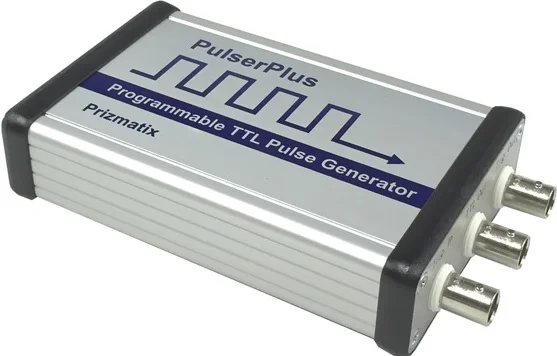Introduction
The Prizmatix Optogenetics-LED-Violet module is specially designed to provide high power Violet light (~405nm) to activate various Opsins with Violet activation spectrum in Optogenetics experiments with freely moving mammals. This LED source provides powerful light irradiance of >380 mW/mm² at fiber implant tip following all fiber-optic connections including Rotary Joint.
Prizmatix unique Optogenetics-LED design enables optional bilateral activation with a single LED and standard rotary joint for significant cost saving and without compromising power at fiber optic canula tip.
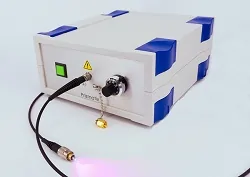
Key Features
- High Power density (>380 mW/mm²) at cannula's fiber tip following all connections
- Unique large LED enables bilateral illumination with single LED and rotary joint for significant cost saving and without compromising power at implant tip.
- Extremely low torque LED-compatible rotary joint suitable for even the smallest animals
- Precisely adjustable power by 10 turns potentiometer
- TTL and Analog Inputs are Opto-Isolated to eliminate ground-loops
- Analog input (0-5V) for power control
- Instant warm up time
Some Research Papers with Reference to Prizmatix's Blue LED...
Optogenetics Toolbox for Freely Moving Mammals Experiments
Prizmatix offers a wide range of standard and customized items comprising the Optogenetics Toolbox. The most useful items for optogenetics experiments in free-moving animals are:
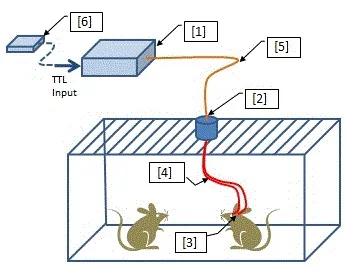
Optical Specifications
| Wavelength | nm | 405 |
| Peak wavelength range | nm | 402-412 |
| Spectrum half width | nm | 27 |
| Optical Power from 200µm NA0.66 fiber (1m) | mW | >18 |
| Optical Power from 250µm NA0.66 fiber (1m) | mW | >24 |
| Optical Power from 500µm NA0.63 fiber (1m) | mW | >120 |
| Optical Power from 1000µm NA0.63 fiber (1m) | mW | >480 |
Optical power and irradiance data for full Optogenetics system including Optogenetics-LED-Violet, fiber patch cord, Rotary Joint, Dual / Single fiber and fiber optic cannula (implant): | ||
| Optical Power from 200µm cannula | mW | >12 |
| Optical Power from 250µm cannula | mW | >18 |
| Optical Power from 500µm cannula | mW | >66 |
| Irradiance from 200µm cannula | mW/mm² | >380 |

[Left]: Optogenetics-LED-Blue
[Right]: Optogenetics-LED-Violet Rise/Fall Time. Ch1 - TTL input , Ch2 Photodiode measurement

Prizmatix‘s unique large emitter LEDs enable bilateral stimulation with a single low cost light source and simple one channel rotary joint. Using a simple Y-shaped fiber bundle at the rotary joint will double the amount of light delivered to the brain each branch delivering virtually the same power as a single fiber. This results in significant cost saving in setting up bilateral brain activation and silencing systems, compared to alternative light sources.

Want to do implant (cannula) by yourself? We offer DIY cannula components such as high NA fibers and ceramic ferrules for online purchases. Please visit:
Electrical Specifications
| Digital modulation input | Optically isolated TTL | |
| Connector for TTL and Analog input | BNC | |
| Digital modulation frequency | Hz | DC-30000 |
| Rise / Fall time (10% - 90%) | µs | <10 |
| Analog input voltage range | V | 0-5 |
| Input Voltage | V | 12 |
| Power Adaptor Input | 85-264 VAC, 47-63Hz,1.5A |
General Specifications
| Operation temperature range | °C | 10-35 |
| Storage Temperature range | °C | -10-35 |
| Operating relative humidity Non condensing |
% | <90 |
| Dimensions (L x W x H) | mm | 197 x 174 x 80 |
| Weight | g | 750 |
| Power Adaptor Dimensions (L x W x H) |
mm | 125 x 50 x 31.5 |
| Power Adaptor Weight | g | 270 |
| Power Adaptor Safety |
|
|
| Fan Noise | dBA | 28.4 |
Optional Accessories
For more details on optional accessories please see:
https://www.prizmatix.com/Optogenetics/Prizmatix-in-vivo-Optogenetics-Toolbox.htm
Rotary JointPrizmatix Rotary Joint is
especially designed for Optogenetics experiments
with High NA fibers equipped with FC connectors.
Rotary Joint very low friction and smooth swivel operation are demonstrated
in this video - showing continuous rotation for over 30 seconds after a
fingertip startup.
The torque required for free movement is very low thus reducing
the Rotary Joint's behavioral effect on freely moving animals. |
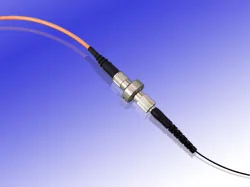 |
Optogenetics Implantable Cannulae

|
Prizmatix Implantable Fiberoptic Cannulae / Ferrules
allow direct light stimulation of certain deep brain regions
in living animals.
Each Cannula consists of a Zirconia ferrule
accommodating a high NA Silica optical fiber, protruding from
the Zirconia ferrule at a desired length. |
Optogenetics Single/Dual Fibers
|
Prizmatix provides a full solution to the optogenetics
in vivo and in vitro fiber optics. Made of silica or polymer fibers,
the high NA fibers are assembled to fit any research set-up with various
combinations of connectors, ferrules, core diameters and lengths.
Some examples are Y-shaped fibers for simultaneous in-vivo
stimulation of two hemispheres, and fibers with stainless steel tip
with protruding bare fibers for in-vitro activation of brain
slices under a microscope. |
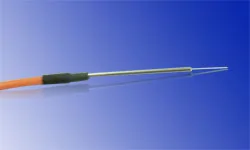
|
Fiber Patch Cords
Prizmatix offers a wide range of standard and customized multi-mode silica / polymer fibers as well as ferrules for optogenetics research. A Y-shaped fiber bundle is especially useful for activating two brain hemispheres simultaneously: a 1000µm or 1500µm fiber is coupled to the LED and connected to one side of the Rotary Joint. From the Joint's other side emerge two thin fibers which can then be connected to two separate ferrules: the light from the LED is divided equally between the two hemispheres without any loss of power.
Pulser
Optogenetics Pulser is a programmable TTL pulse train generator for pulsing LEDs, lasers and shutters used in Optogenetics activation. The Pulser device comes with user friendly software that enables easy visual setup of numerous pulse train configurations. See Pulser product details
